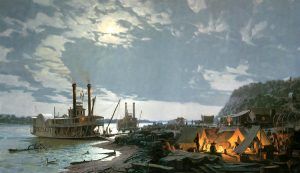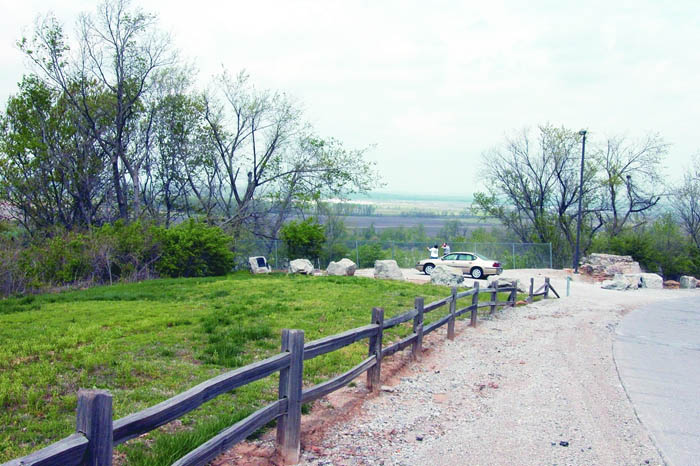
Wayne City Landing: Where America’s West Began, Then Faded to a Whisper
On an unassuming patch of earth in St. Charles County, Missouri, where the mighty Missouri River makes its final, sweeping bend before surrendering to the embrace of the Mississippi, lies a place known as Wayne City Landing. Today, it is largely quiet, perhaps marked only by a historical plaque or a quiet stretch of riverbank, if anything at all. The roar of commerce has long since faded, the bustling energy of a burgeoning frontier port replaced by the rustle of wind through cottonwoods and the ceaseless, ancient murmur of the river itself. Yet, for those who know its story, Wayne City Landing is far more than a forgotten waypoint; it is a foundational touchstone in the narrative of American expansion, a silent witness to the dawn of a continent-spanning dream.
This is not a story of grand cities that soared to prominence, nor of enduring monuments that defy the ravages of time. Instead, the tale of Wayne City Landing is one of profound historical significance tied to a fleeting moment, a testament to the ephemeral nature of river towns, and the relentless, transformative power of the very waterways that once defined them. It is a story of beginnings, of the raw ambition that pushed a young nation westward, and of the quiet fading that often follows the most pivotal moments.
The Confluence: A Geographic Nexus

To understand Wayne City Landing, one must first grasp the immense geographic importance of its location. It sits mere miles upstream from the Confluence, the sacred meeting point of the Missouri and Mississippi Rivers, often called "the great rivers." For millennia, this confluence has been a strategic heartland for indigenous peoples, a natural crossroads for trade, and a vital point of navigation. The Mississippi, flowing north-south, connected the vast interior of the continent to the Gulf of Mexico, while the Missouri, stretching over 2,300 miles westward, offered a watery highway deep into unexplored territories.
For early American explorers and settlers, the Confluence was not merely a geographical curiosity; it was the ultimate gateway. To venture west meant to enter the Missouri River, a powerful, unpredictable, and often treacherous artery that promised both unparalleled opportunity and immense peril. Wayne City Landing, positioned at the mouth of this formidable river, on its south bank (the Missouri side), naturally became a logical point of departure or arrival for those navigating its currents.
The Winter of Discovery: Lewis & Clark’s Launchpad
The most indelible chapter in Wayne City Landing’s history is inextricably linked to the Corps of Discovery. In December 1803, Captain Meriwether Lewis and William Clark, charged by President Thomas Jefferson with exploring the newly acquired Louisiana Purchase, established their winter encampment, Camp Dubois (also known as Camp Wood), across the Mississippi River on the Illinois side. This strategic decision placed them at the confluence, allowing them to prepare for their epic journey up the Missouri.
While Camp Dubois was their primary base, the immediate vicinity, including the Missouri bank where Wayne City Landing would later be designated, served as the true jumping-off point for their grand expedition. It was from this area, after a grueling winter of preparation, training, and gathering supplies, that the Corps of Discovery officially launched their keelboat and two pirogues on May 14, 1804.
Imagine the scene: the crisp spring air, the churning waters of the Missouri, the anticipation etched on the faces of the 40-plus men, a mix of soldiers, hunters, and boatmen. They were venturing into the unknown, guided only by vague maps and the boundless curiosity of their leaders. This moment, often romanticized as the "start of the expedition," literally began at the mouth of the Missouri, right where Wayne City Landing silently observes the river today.
Clark’s journal entry for that pivotal day simply states: "Set out at 4 oClock P. M. in the presence of many of the neighboring inhabitants, and proceeded on under a jentle brease up the Missouri." The "neighboring inhabitants" would have included early settlers, traders, and perhaps curious Native Americans, all gathered to witness this historic departure. Wayne City Landing, though not formally named as such then, was the witness to this monumental event, the last glimpse of established American civilization for the Corps for over two years.
From Landing to Town: A Brief Flourish

In the decades following Lewis and Clark, the area around the Confluence continued to grow in importance. St. Louis, just downstream on the Mississippi, rapidly emerged as the "Gateway to the West," a bustling hub for the fur trade, and later, for westward migration. But for those specifically venturing up the Missouri, a point of access and a small community at its mouth was still valuable.
Wayne City Landing emerged as a small settlement, a river landing designed to facilitate trade and travel on the Missouri River. It served as a transfer point for goods and passengers moving between the Mississippi and Missouri river systems. Steamboats, the marvels of 19th-century transportation, would have regularly docked here, their powerful engines churning the muddy waters, their whistles echoing across the floodplain. Flatboats, keelboats, and later, larger barges would have loaded and unloaded supplies: furs coming downriver, manufactured goods, seeds, and eager settlers heading up.
Early land records and historical accounts suggest that Wayne City, as a nascent town, had aspirations. There might have been a general store, a tavern, a blacksmith, perhaps a handful of homes – the typical trappings of a frontier community hoping to capitalize on its strategic location. It was a place where information about the vast western territories could be gleaned, where supplies for the long journey could be purchased, and where one last taste of civilization could be savored before the wilderness swallowed them whole.
However, its proximity to the powerful and rapidly growing St. Louis, coupled with the inherent challenges of river life, meant that Wayne City Landing never truly flourished into a major urban center. St. Louis had deeper roots, a more established infrastructure, and the distinct advantage of being at the crossroads of both major rivers, not just the mouth of one.
The River’s Embrace: A Cycle of Creation and Destruction
One cannot discuss Wayne City Landing without acknowledging the river’s profound, almost sentient, influence. The Missouri River, often called "Big Muddy," is notorious for its shifting channels, its powerful currents, and its dramatic flood cycles. For centuries, these floods have shaped the landscape, depositing rich alluvial soil, but also relentlessly eroding banks, consuming structures, and redefining boundaries.
Wayne City Landing, like many river towns, was built on the floodplain, a perilous but fertile location. While the floods brought renewal and fertile ground for agriculture, they also brought devastation. Buildings would be submerged, land would be washed away, and the very course of the river could shift, leaving once-bustling landings high and dry, or swallowed by the current.
This constant battle with the river played a significant role in Wayne City Landing’s inability to achieve lasting prominence. Each major flood would force residents to rebuild, to relocate, or eventually, to abandon the struggle. Over time, the energy and resources required to maintain a presence in such a dynamic environment proved too great for a small community competing with a juggernaut like St. Louis. The river, which had given it life as a landing, ultimately contributed to its quiet demise as a vibrant town.
"The river doesn’t care about our maps or our property lines," a local historian might muse, contemplating such a site. "It follows its own ancient course, and those who build upon its banks do so at its pleasure." This sentiment perfectly encapsulates the fate of places like Wayne City Landing, where human ambition clashed with the raw, untamed power of nature.
A Legacy of Silence and Reflection
Today, Wayne City Landing is not a bustling port or a thriving town. It is, for most, simply a name on an old map, or perhaps a reference point for historical societies and river enthusiasts. The exact location of the original "landing" might be difficult to pinpoint with precision, having likely been altered by floods and the passage of time. The land is probably privately owned, perhaps farmed, or left to natural reclamation.
Yet, its legacy endures. Wayne City Landing serves as a powerful reminder of several crucial aspects of American history:
- The Starting Line: It marks the true physical beginning of the Lewis & Clark Expedition, a journey that fundamentally reshaped the map and destiny of the United States. Without that departure point, the westward expansion might have taken a different course.
- The Frontier’s Impermanence: It illustrates the fleeting nature of many frontier settlements, particularly those reliant on the unpredictable power of rivers. Not every promising "landing" became a city; many faded into obscurity, their stories etched only in obscure records and the memories of a few.
- The River’s Dominance: It underscores the profound influence of the Missouri and Mississippi Rivers on the development of the American interior. They were both highways and hazards, lifelines and destroyers, dictating where people settled, how they traveled, and ultimately, whether their endeavors succeeded or failed.
- The Power of Place: Even in its quietude, Wayne City Landing evokes a sense of deep history. Standing on its banks, one can almost hear the creak of the keelboat, the shouts of the boatmen, and the hopeful whispers of those embarking on a journey into the unknown. It’s a place that invites contemplation about the courage of those early pioneers and the vastness of the land they sought to conquer.
In a world obsessed with the new and the immediate, there is profound value in remembering places like Wayne City Landing. They are the quiet corners where monumental events unfolded, the unassuming backdrops against which the grand narratives of history were written. They teach us about the challenges and triumphs of our ancestors, the relentless forces of nature, and the ever-changing landscape of human endeavor.
So, while you won’t find bustling shops or grand monuments at Wayne City Landing today, what you will find, if you listen closely, is the whisper of history carried on the wind and the ceaseless current of the river – a timeless testament to where America’s westward journey truly began. It is a place of quiet reflection, a portal to a bygone era, reminding us that even the most pivotal starting points can, over time, fade into the silent embrace of the earth and the water.


